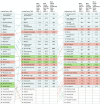Child and Adolescent Health From 1990 to 2015: Findings From the Global Burden of Diseases, Injuries, and Risk Factors 2015 Study
- PMID: 28384795
- PMCID: PMC5540012
- DOI: 10.1001/jamapediatrics.2017.0250
Child and Adolescent Health From 1990 to 2015: Findings From the Global Burden of Diseases, Injuries, and Risk Factors 2015 Study
Erratum in
-
Errors in Author Names and Affiliations.JAMA Pediatr. 2017 Jun 1;171(6):602. doi: 10.1001/jamapediatrics.2017.1667. JAMA Pediatr. 2017. PMID: 28586793 Free PMC article. No abstract available.
-
Addition of Open Access, Funding/Support, and Role of Funder/Sponsor Information.JAMA Pediatr. 2017 Oct 1;171(10):1019. doi: 10.1001/jamapediatrics.2017.2732. JAMA Pediatr. 2017. PMID: 28806443 Free PMC article. No abstract available.
Abstract
Importance: Comprehensive and timely monitoring of disease burden in all age groups, including children and adolescents, is essential for improving population health.
Objective: To quantify and describe levels and trends of mortality and nonfatal health outcomes among children and adolescents from 1990 to 2015 to provide a framework for policy discussion.
Evidence review: Cause-specific mortality and nonfatal health outcomes were analyzed for 195 countries and territories by age group, sex, and year from 1990 to 2015 using standardized approaches for data processing and statistical modeling, with subsequent analysis of the findings to describe levels and trends across geography and time among children and adolescents 19 years or younger. A composite indicator of income, education, and fertility was developed (Socio-demographic Index [SDI]) for each geographic unit and year, which evaluates the historical association between SDI and health loss.
Findings: Global child and adolescent mortality decreased from 14.18 million (95% uncertainty interval [UI], 14.09 million to 14.28 million) deaths in 1990 to 7.26 million (95% UI, 7.14 million to 7.39 million) deaths in 2015, but progress has been unevenly distributed. Countries with a lower SDI had a larger proportion of mortality burden (75%) in 2015 than was the case in 1990 (61%). Most deaths in 2015 occurred in South Asia and sub-Saharan Africa. Global trends were driven by reductions in mortality owing to infectious, nutritional, and neonatal disorders, which in the aggregate led to a relative increase in the importance of noncommunicable diseases and injuries in explaining global disease burden. The absolute burden of disability in children and adolescents increased 4.3% (95% UI, 3.1%-5.6%) from 1990 to 2015, with much of the increase owing to population growth and improved survival for children and adolescents to older ages. Other than infectious conditions, many top causes of disability are associated with long-term sequelae of conditions present at birth (eg, neonatal disorders, congenital birth defects, and hemoglobinopathies) and complications of a variety of infections and nutritional deficiencies. Anemia, developmental intellectual disability, hearing loss, epilepsy, and vision loss are important contributors to childhood disability that can arise from multiple causes. Maternal and reproductive health remains a key cause of disease burden in adolescent females, especially in lower-SDI countries. In low-SDI countries, mortality is the primary driver of health loss for children and adolescents, whereas disability predominates in higher-SDI locations; the specific pattern of epidemiological transition varies across diseases and injuries.
Conclusions and relevance: Consistent international attention and investment have led to sustained improvements in causes of health loss among children and adolescents in many countries, although progress has been uneven. The persistence of infectious diseases in some countries, coupled with ongoing epidemiologic transition to injuries and noncommunicable diseases, require all countries to carefully evaluate and implement appropriate strategies to maximize the health of their children and adolescents and for the international community to carefully consider which elements of child and adolescent health should be monitored.
Conflict of interest statement
Figures



Comment in
-
Importance of Innovations in Neonatal and Adolescent Health in Reaching the Sustainable Development Goals by 2030.JAMA Pediatr. 2017 Jun 1;171(6):521-522. doi: 10.1001/jamapediatrics.2017.0261. JAMA Pediatr. 2017. PMID: 28384685 No abstract available.
References
-
- The United Nations Convention on the Rights of the Child. New York, NY: United Nations; 1989. Treaty Series; 1577, 3.
-
- United Nations Millennium Development Goals and beyond 2015. http://www.un.org/millenniumgoals/. Published October 29, 2015. Accessed October 29, 2015.
-
- United Nations Sustainable Development Goals. http://www.un.org/sustainabledevelopment/sustainable-development-goals/. Accessed October 29, 2015.
MeSH terms
LinkOut - more resources
Full Text Sources
Other Literature Sources
Medical

